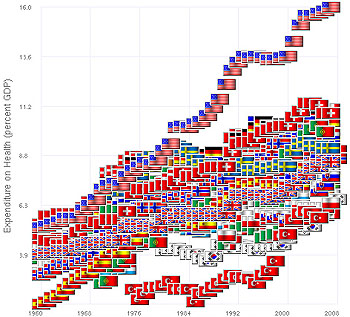Yuval Levin thinks that the Simpson-Bowles deficit commission’s failure to take on healthcare is its biggest weakness. I agree! But then he goes on to say this:
Obamacare itself cannot just be reformed, because it is deeply rooted in exactly the wrong idea about how to control health-care costs….It puts into practice the notion that the way to make health-care financing more efficient is to make it a centralized system managed largely by the government, so that the only way to really squeeze costs is to tighten price controls.
If you do not think that this is how economic efficiency happens, then you cannot expect any form of this approach to address the basic problem with American health care, and indeed you would expect this approach to result in lower quality and less readily available care.
It’s remarkable that conservatives can continue saying stuff like this. Every other advanced country in the world has a centralized healthcare system that  largely controls costs via government mandates. And guess what? It demonstrably works. Every other advanced country in the world has significantly lower costs than ours and provides more readily available care, and nearly all of them provide healthcare that’s at least as good or better than ours.
largely controls costs via government mandates. And guess what? It demonstrably works. Every other advanced country in the world has significantly lower costs than ours and provides more readily available care, and nearly all of them provide healthcare that’s at least as good or better than ours.
The chart on the right has been making the rounds lately, and it shows the healthcare cost situation pretty clearly. We’ve always been near the top of the pack compared to other countries, but around 1980 U.S. healthcare costs started to explode. While other countries have seen their costs rise about 50% or so over the past 30 years, ours have skyrocketed, nearly doubling as a percent of GDP.
If you break this down, you can try to figure out exactly which costs are responsible for this rise. But the big picture is clear: other countries had centralized systems that controlled costs and we didn’t. And the centralized systems worked: they reined in costs while continuing to provide extremely high-quality healthcare. You might not like that from an ideological perspective, but from a practical one you can hardly deny that it worked pretty well.

















